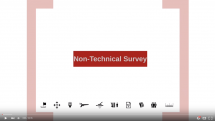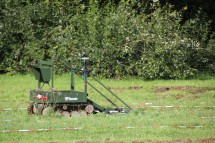Links
TIRAMISU Newsletter
http://www.fp7-tiramisu.eu/sites/fp7-tiramisu.eu/files/publications/TIRAMISU%20%...
This first issue lists some of the robotic tools that were tested last year. It also describes a concept for labels that could help understand visually the main characteristics of a given tool, whether it is a detector, mechanical equipment, software, personal protective equipment, etc.
An introduction to our work to propose guidelines to test and evaluate personal protective equipment and propose acceptance tests for demining machines that are not designed to damage or destroy mines is also given.
http://www.fp7-tiramisu.eu/sites/fp7-tiramisu.eu/files/publications/TIRAMISU%20n...
You will first read in this new publication about the TIRAMISU Final Demonstration which took place on the 24th of September 2015 in Meerdael (Belgium). You will also learn about the deployment of a TIRAMISU robotic tool successfully tested last year in Bosnia and Herzegovina during a real crisis response scenario. The University of Coimbra (Portugal) will then share its view on how the different TIRAMISU tools can be used to foster the development of new robotics algorithms in the benefit of the mine action community. The Royal Military Academy (Belgium) will also present a new technique to test personal protective equipment against multiple and simultaneous fragments occurring after a landmine explosion. The newsletter will end with a description of an original method developed by the University of Zagreb (Croatia) using bees to detect explosives and unexploded landmines
Humanitarian Demining
http://www.ctro.hr/eng/
The Croatian Mine Action Center for testing, development and training Ltd. (HCR-CTRO d.o.o.) was established in 2003 with the aim of encouraging, assisting and developing field tests and evaluation of mine and UXO detection technologies, and of performing systematic tests, examination and development of mine action.
http://www.mineaction.org/
Information gateway developed to support both the planning and coordination of globalmine action efforts by making available to all partners reliable information on mine action programmes, issues, best practices, technologies, Resources, projects, news awareness and contact. “Mine Action” includes demining, as well as victim assistance, mine-risk education, destruction of stockpiled landmines and advocating for a world free of the threat of landmines.
http://www.gichd.org/
The Geneva International Centre for Humanitarian Demining (GICHD), an international expert organisation legally based in Switzerland as a non-profit foundation, works for the elimination of mines, explosive remnants of war and other explosive hazards, such as unsafe munitions stockpiles.
http://en.wikipedia.org/wiki/Demining#Humanitarian_demining
In times of relative peace, the process of mine removal is referred to as demining. This is a thorough, time-intensive process that seeks to locate all mines so that the land or sea area may be safely returned to normal use. It is vital that this process be exhaustive. Even if only a small handful of mines remain undiscovered, incomplete demining can actually lead to an increase in civilian mine casualties as local people re-occupy and area they previously avoided in the belief that it has been made safe.
http://iarp.isir.upmc.fr/
The international collaborative project that is now designated as the “International Advanced Robotics Programme” (IARP) was initiated at the Versailles Economic Summit of 1982. Participating countries at present are Austria, Belgium, Brazil, Canada, China, France, Germany, Italy, Japan, Korea, Spain, Russia, UK and USA. The European Union and New Zealand are observer members. All of these countries have agreed to the general objective of the IARP: to foster international cooperation aiming to develop robot systems able to dispense with human exposure to difficult activities in harsh, demanding or dangerous conditions or environments.
http://www.icbl.org/
A global network in some 100 countries working for a world free of landimes.The International Campaign to Ban Landmines (ICBL) is a global network in some 100 countries that works for a world free of antipersonnel landmines, where landmine survivors can lead fulfilling lives. The Campaign was awarded the Nobel Peace Prize in recognition of its efforts to bring about the 1997 Mine Ban Treaty. Since then, we have been advocating for the words of the treaty to become a reality, demonstrating on a daily basis that civil society has the power to change the world.
http://www.itep.ws/
ITEP’s mission is to develop standards, coordinate and perform tests of materials and methods, and spread information about the results to all other interested parties. ITEP will by this means contribute to the resolution of the global landmine problem through impacting the acquisition process towards better, safer, and more cost-effective equipment and methods. Co-utilization of resources and expertise from participating ITEP countries will allow allocated resources to be used more efficiently, thus contributing to improvement of global humanitarian demining programs.
http://www.maginternational.org/
A neutral and impartial humanitarian organisation, MAG works in current and former conflict zones to reduce the threat of death and injury from remnants of conflict.These include anti-personnel and anti-vehicle landmines, as well as rockets, missiles, mortars, grenades, ammunition, Small Arms and Light Weapons, and many more types of deadly items. It carries out landmine and bomb clearance, as well as even about landmines.MAG educates people living, working and travelling through contaminated areas, to minimise the risks of them, their friends and families being killed or maimed.
http://maic.jmu.edu/journal/index/
The Journal of ERW and Mine Action is a forum for humanitarian mine action- and explosive remnants of war-clearance best practices and methodologies, strategy planning, mine-risk education, and survivors’ assistance.The Journal began in 1997 and is the longest continuous source of information on ERW and Mine Action in the world. The online version of The Journal receives more than 169,000 unique visitors per year (2010-2011). The Journal is read, either in print or online, in more than 150 countries.
http://mecatron.rma.ac.be/
The Unmanned Vehicle Centre of the Department of Mechanics of the Belgian Royal Military Academy a research laboratory specialised in the design, development and control of unmanned systems, both unmanned ground vehicles (ugv) and unmanned aerial vehicles (uav). The lab conducts research in varied domains, ranging from very fundamental aspects to the development of prototype products, this in order to fulfill the 3 mission objectives of the Unmanned Vehicle Centre: Research, Education and Support Services.
http://www.humanitariandemining.org/
















